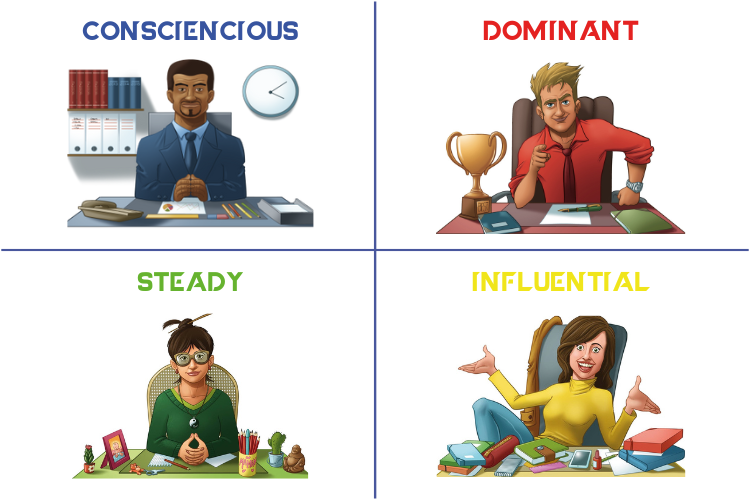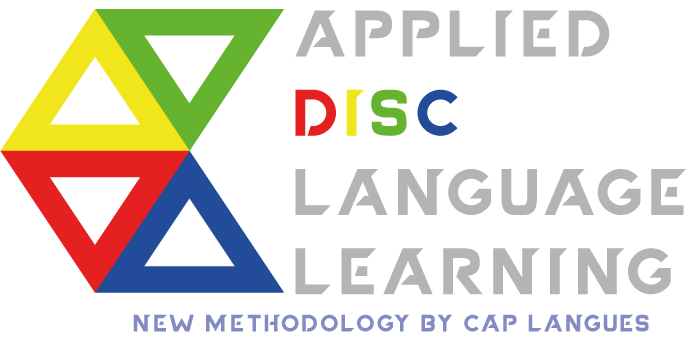Sprache auswählen
Method of Practice
Transforming Language Teaching
Cap Langues's main differentiator as a language provider, is the use of DISC personality profiling in the classroom.
Since the 1980s, language teaching has remained relatively unchanged; even with the introduction of eclectic methods, outcomes have been the same. Applied DISC Language learning on the other hand, is the game-changer that students and teachers around the world have been waiting for, for decades.
The cornerstone of the Applied DISC Language Learning method of practice is recognising that while it is natural to teach a language the way we prefer to learn, the key to maximising learning effectiveness lies in customising the approach to meet the student's specific needs. Thus, it is essential for the teacher to adapt their teaching methods to the ways in which the student most effectively absorbs and utilises the language.

DISC as the Ultimate Tool for Innovative Language Teaching
After evaluating various tools, the DISC model emerged as the best choice for developing a new method of practice due to its neutral and non-judgmental approach to observing behaviors and emotions. Unlike other tools that may impose rigid personality labels, DISC’s flexibility allows for continuous refinement and tailoring to meet the dynamic needs of students. This promotes a more inclusive approach that respects individual differences and fosters a more effective and engaging educational environment.
The Relevance of DISC Profiling to Language Teaching

DISC
Profiling
Personalised Learning Strategies for Language Acquisition DISC profiling, it provides a framework that offers language teachers valuable insights into student learning preferences and communication styles. The system categorises individuals into four key groups: Dominant (D), Influential (I), Steady (S), and Compliant (C).

Understanding Student Preferences
DISC profiles equip teachers with a better understanding of how individual students approach language acquisition. For instance, students with a Dominant profile may flourish in environments that emphasize goal-oriented challenges. Conversely, students with an Influential profile may demonstrate greater engagement in collaborative and interactive settings.

Adapting Teaching Methods
By leveraging this knowledge, teachers can strategically adapt their teaching methods to exploit the strengths of each individual student. For example, students with a Steady profile style may benefit from a structured and predictable approach, while students with a Compliant profile may appreciate clear explanations and detailed instructions.

Enhancing Learning Outcomes
By aligning instruction with individual learning preferences, DISC profiling offers a more engaging and effective learning environment. This, in turn, boosts student motivation, knowledge retention, and overall learning outcomes.
In conclusion, DISC profiling is a valuable tool for personalising language instruction. By understanding students' unique learning preferences, teachers can create a more enriching learning experience that leads to effective language acquisition.
Benefits of combining DISC profilling with language teaching

Individualised Learning Plans
Cap Langues leverages DISC profiles to create customised learning plans that cater to individual needs and goals. This ensures a more enjoyable and effective learning journey, optimising progress towards fluency.

Elevated Communication Skills
By understanding communication styles through DISC profiling, ADLL facilitates more effective communication both in the classroom and in real-world settings. Enhanced communication skills promote confidence and facilitate stronger interpersonal relationships.

Improved Team Dynamics
ADLL recognises and values the diversity of communication styles present within a learning environment. This encourages collaboration and better communication within teams, ultimately leading to improved peer learning and collective success.

Enhanced Conflict Resolution
From a teaching perspective, DISC profiling provides valuable tools for identifying potential communication conflicts and strategies for resolving them constructively. This not only offers benefits for language learning but also helps navigate conflicts in everyday life.

Enhanced Learning Efficiency
DISC profiling allows our teachers to adapt their methods according to individual learning preferences. This targeted approach encourages more effective language acquisition in comparison to traditional approaches.

Beyond Vocabulary and Grammar
The ADLL method of practice goes beyond grammar drills, memorisation of vocabulary and syntax. ADLL helps to unlock linguistic potential, so that students can benefit from the many advantages of multilingualism.
Unlocking Learning Potential: DISC Profiles in Action
DISC profiling categorises individuals into four distinct behavioral categories. It effectively distinguishes between "adapted personality traits" (how individuals behave in professional contexts) and "natural traits" (their inherent preferences, needs, and goals).
By integrating DISC profiling into our teaching methods, we can tailor learning and development plans to match students' natural learning styles. This gives our teachers insight into students' learning needs even before the first meeting. This personalized approach has proven to significantly enhance student engagement.
This method of practice, establishes a pedagogical connection between teachers and students right from the start, leading to a more effective and highly personalised language learning experience.
To show how each DISC profile learns, we have created a visual representation that showcases the unique learning styles associated with Dominant, Influential, Steady, and Compliant profiles. In an individual class, this approach translates into personalised lesson plans where activities are tailored to match the student's DISC profile. In a group class, we foster collaboration between students with different DISC profiles by offering activities, discussions, and projects that enable them to leverage their unique strengths to achieve shared goals.

Dominant
Learning Style: Learns by doing, enjoys challenges, and taking risks. Effective Methods: Debates, dynamic role-playing, goal-oriented exercises, practical simulations, immediate feedback. Preferred Environment: Dynamic, stimulating, with a variety of tasks and clear objectives.
Influential
Learning Style: Learns through exchange and creativity, likes to have fun and share. Effective Methods: Presentations, speeches, cultural exploration, discussions on current articles, language games, interactive activities. Preferred Environment: Social, collaborative, with a fast pace and varied activities.
Stable
Learning Style: Learns by observing, seeks to understand processes, and follow instructions. Effective Methods: Reading comprehension, vocabulary expansion, conversation practice, grammar exercises, pronunciation workshops. Preferred Environment: Predictable, safe, with structured progression and detailed explanations.
Consciencious
Learning Style: Learns by analyzing, reflecting, and delving into details. Effective Methods: Grammar exercises, sentence structure analysis, word associations, critical studies, error correction. Preferred Environment: Structured, methodical, with detailed information and well-defined tasks.
Frequently Asked Question
A: DISC profiling categorizes individuals into four key groups: Dominant (D), Influential (I), Steady (S), and Compliant (C).







